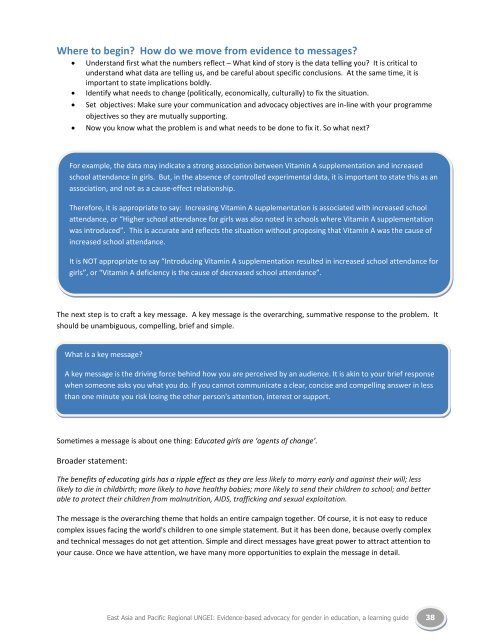Evidence-Based Advocacy - United Nations Girls' Education Initiative
Evidence-Based Advocacy - United Nations Girls' Education Initiative
Evidence-Based Advocacy - United Nations Girls' Education Initiative
You also want an ePaper? Increase the reach of your titles
YUMPU automatically turns print PDFs into web optimized ePapers that Google loves.
Where to begin? How do we move from evidence to messages?<br />
<br />
<br />
<br />
<br />
Understand first what the numbers reflect – What kind of story is the data telling you? It is critical to<br />
understand what data are telling us, and be careful about specific conclusions. At the same time, it is<br />
important to state implications boldly.<br />
Identify what needs to change (politically, economically, culturally) to fix the situation.<br />
Set objectives: Make sure your communication and advocacy objectives are in-line with your programme<br />
objectives so they are mutually supporting.<br />
Now you know what the problem is and what needs to be done to fix it. So what next?<br />
For example, the data may indicate a strong association between Vitamin A supplementation and increased<br />
school attendance in girls. But, in the absence of controlled experimental data, it is important to state this as an<br />
association, and not as a cause-effect relationship.<br />
Therefore, it is appropriate to say: Increasing Vitamin A supplementation is associated with increased school<br />
attendance, or “Higher school attendance for girls was also noted in schools where Vitamin A supplementation<br />
was introduced”. This is accurate and reflects the situation without proposing that Vitamin A was the cause of<br />
increased school attendance.<br />
It is NOT appropriate to say “Introducing Vitamin A supplementation resulted in increased school attendance for<br />
girls”, or “Vitamin A deficiency is the cause of decreased school attendance”.<br />
The next step is to craft a key message. A key message is the overarching, summative response to the problem. It<br />
should be unambiguous, compelling, brief and simple.<br />
What is a key message?<br />
A key message is the driving force behind how you are perceived by an audience. It is akin to your brief response<br />
when someone asks you what you do. If you cannot communicate a clear, concise and compelling answer in less<br />
than one minute you risk losing the other person's attention, interest or support.<br />
Sometimes a message is about one thing: Educated girls are ‘agents of change’.<br />
Broader statement:<br />
The benefits of educating girls has a ripple effect as they are less likely to marry early and against their will; less<br />
likely to die in childbirth; more likely to have healthy babies; more likely to send their children to school; and better<br />
able to protect their children from malnutrition, AIDS, trafficking and sexual exploitation.<br />
The message is the overarching theme that holds an entire campaign together. Of course, it is not easy to reduce<br />
complex issues facing the world's children to one simple statement. But it has been done, because overly complex<br />
and technical messages do not get attention. Simple and direct messages have great power to attract attention to<br />
your cause. Once we have attention, we have many more opportunities to explain the message in detail.<br />
East Asia and Pacific Regional UNGEI: <strong>Evidence</strong>-based advocacy for gender in education, a learning guide 38

















